 |
|

|
 |
TABLE of CONTENTS
 |
Black History Month events to highlight African American contributions to transportation |
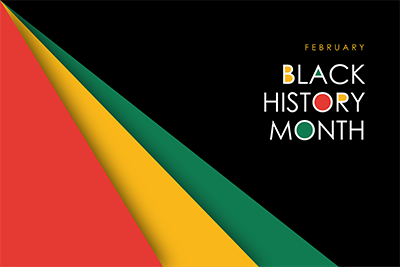
Celebrate Black History Month with AAERG. |
By Mary Schaefle, Office of Financial Management
The African American Employee Resource Group is celebrating Black History Month by showcasing African American innovators and inventors in the field of transportation. The planned events include a series of Lunch and Learns, a trivia challenge and articles on prominent but often overlooked figures.
“AAERG invites all MnDOT employees to join us for these events and activities and learn more,” said AAERG chair Jesse Johnson, Metro District. "These are fascinating and important stories about how we see Black history in our daily lives. We are looking forward to sharing them with everyone at MnDOT."
Closed captioning is available for Lunch and Learn events. These events will be recorded and posted on the ERG events page for later use.
Lunch and Learn: Diversity, Equity and Inclusion at State DOTs
Join AAERG for a fireside chat with leaders in diversity, equity, and inclusion at other state Departments of Transportation. The moderated panel will highlight efforts at their state DOTs and in their communities.
Lunch and Learn: Hidden in Plain Sight: A History of the Places We Go
Professor Christopher Lehman, Professor of Ethnic Studies at St. Cloud State University, will share the history of southern slaveholders and their influence on Minnesota commerce and economy as they traveled to Minnesota seeking new opportunities before the Civil War. Professor Lehman’s award-winning book “Slavery’s Reach: Southern Slaveholders in the North Star State” will serve as the foundation for this presentation. Read more about Professor Lehman on the Minnesota Writers Directory.
African American inventors and pioneers in transportation
African Americans have patented items, created foundational systems and championed new additions to the transportation system. Visit the AAERG page on iHUB to read short biographies of three of these individuals, including Garrett Morgan’s, creator of the three-signal traffic light; Gladys West, whose work laid the foundation for GPS; and Lois Cooper, an early innovator in HOV lanes and bike paths.
Black history trivia
AAERG is hosting an ongoing trivia game for the month of February. Sign up to participate in the Black history trivia game
Connect with the AAERG
To learn more about the group, including how to join, visit their page on visit the AAERG page on iHub. |
| |
|

|
 |
TABLE of CONTENTS
 |
Legislative session opens with new proposals for policies, funding affecting transportation |
By Doug Mack and Joe Nietfeld, Government Affairs
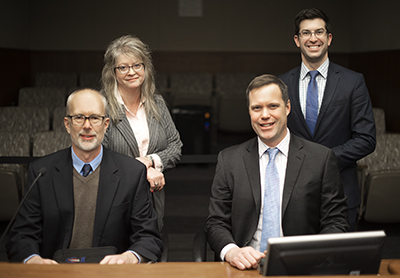
The MnDOT staff working with the Governor and the Legislature includes Erik Rudeen, Government Affairs Office director, Jennifer Witt, Legislative coordinator, Joe Nietfeld, Legislative liaison and John Dukich, Legislative Affairs manager. Photo by Rich Kemp |
The 2023 Legislative session officially began on Jan. 3, and in the ensuing weeks, lawmakers and Gov. Walz have offered a rush of new policy and funding proposals, including many that affect MnDOT.
This swift action has included passage, in the House and Senate, of bills that provide MnDOT with the budget authority to spend federal IIJA funds of $4.8 billion, spread over five years, for work on Minnesota for highways and bridges.
All told, there are a 22 specific budget items relating to MnDOT, including:
- $364 million of new one-time money from the General Fund to cover IIJA match for the modes and local transportation
- $358 million of new one-time money from the General Fund transferred directly to the Trunk Highway Fund
- Proposed changes to motor vehicle registration taxes, which would generate approximately $698 million in new transportation revenue to the Highway User Tax Distribution Fund over the next four years
- Significant proposed increases in operating appropriations to cover estimated compensation and IT cost increases
“With a massive state budget surplus, a backlog of transportation funding and policy priorities, and an infusion of federal transportation funds flowing to Minnesota, we are hopeful to see significant legislative action this session that will make lasting contributions to improve the state’s infrastructure.” said John Dukich, MnDOT Manager of Legislative Relations.
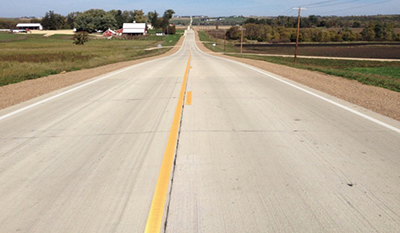
Gov. Walz recommends $4.8 million for the Transportation Economic Development Infrastructure program. Past projects funded by the program include upgrades to TH 52 in Zumbrota. Photo courtesy of District 6 |
In addition to the operating budget proposals, Gov. Walz has also released his capital budget recommendations, which include a total of $471.2 million proposed for MnDOT for 12 requests. More details about these requests are available from MMB, with the MnDOT specific requests on pages 24-26.
Other policy priorities for MnDOT include bills relating to Indian Employment preferences, the electric vehicle infrastructure, turnbacks, historic bridges, direct negation for maintenance work on department-owned buildings and expanded eligibility for tribal nations in some of MnDOT’s grant programs. The full list of MnDOT’s 2023 legislative proposals is available on iHUB.
Since the beginning of the session, the agency’s Government Affairs staff has been busy attending the House Transportation Finance and Policy Committee, the House Sustainable Infrastructure Policy Committee, the Senate Transportation Committee and other committee meetings as needed. Government Affairs staff has also been meeting one-on-one with Representatives and Senators from across the state to discuss ongoing projects, issues and MnDOT’s 2023 legislative proposals. The Commissioner and staff from the MnDOT Offices of Sustainability, Finance and Tribal Affairs have also provided testimony this session, with more to come.
One topic of particular interest, according to Government Affairs staff, has been sustainability. Legislators have had many questions about climate and sustainability initiatives such as electric buses and electric vehicle charging stations, and there is an entirely new committee for these issues, the House Sustainable Infrastructure Policy Committee, which is chaired by Rep. Erin Koegel.
The committee’s aim is to look beyond the two-year budget cycle and consider opportunities for state and local communities to take advantage of the federal infrastructure funding. It will provide resources to help local communities apply for federal infrastructure funding and provide project development, administration and reporting support. |
| |
|

|
 |
TABLE of CONTENTS
 |
Employee survey aims to assess and improve agency function |
By Doug Mack
As part of the state executive branch’s ongoing efforts to improve workplace satisfaction and function for all employees, MNIT sent out an email last week – on Jan. 25 for some MnDOT employees and Jan. 26 for others – with a link to the 2023 Engagement and Inclusion Survey. Employees who have not received a link to the survey via their work email should contact Management Analysis and Development, also known as MAD, at 651-259-3800 or Management.Analysis@state.mn.us.
MNIT, along with MnDOT leadership, encourages all agency employees to complete the survey, which takes about 15 minutes, by Wednesday, Feb. 22. Each email has a unique link, so employees should use the specific email sent to them (for more about this, see the Frequently Asked Questions below).
The Engagement and Inclusion Survey is an opportunity for executive branch employees to share what is going well and where we need to improve. The survey also has questions for employees to share their experiences about workplace inclusion and engagement. Feedback from this survey will help the agency develop action plans to help support employees and foster a respectful workplace; it also provides a way for MnDOT to measure progress since the 2018 and 2020 surveys.
The last survey, which MMB launched in December 2020, showed that most respondents were satisfied with their job (81%) and most understood the impact of their work (95%). But the survey also highlighted specific areas in which respondents desired change. Based on this survey feedback, MnDOT has worked to implement or expand several programs and initiatives, including:
- Providing more mobility opportunities, stretch assignments and access to internal rotations.
- Updating the Leadership Development Program
- Offering more opportunities to engage with the Commissioner, Deputy Commissioners and members of the Executive Leadership Team (such as town halls or site visits).
- Providing more opportunities for non-mandatory Diversity, Equity, and Inclusion training.
- Evaluating employee retention strategies (such as flexible scheduling, telework, tuition reimbursement program and job redesign).
Frequently Asked Questions
Can I take the survey during my work shift?
Yes, you should take the survey during your regular workday.
How long is the survey?
The survey will take about 15 minutes to complete. If you cannot complete the survey at one time, select “Save” at the bottom of the page to save your answers. You can return to complete the survey later by using the survey link you received.
Who is running the Engagement and Inclusion Survey?
Enterprise Employee Experience within Minnesota Management and Budget leads the Enterprise Engagement and Inclusion Survey as a tool to drive engagement across all state government agencies. EEE has contracted with Management Analysis and Development to administer the survey and analyze enterprise-wide results.
Why is a survey happening right now?
The survey is typically administered every other year and provides an opportunity for employees to offer feedback to leadership, which helps guide the future of the agency. This input – positive, critical and otherwise — is especially important now, in light of the significant changes to both the workplace and daily life over the past three years.
Is the survey private? Who will know if I participated?
Only MAD will know whether you took the survey and what you answered. Your agency will not know who took the survey and who provided which answers. Information that could reasonably be used to identify an individual from their response is considered private data under the Minnesota Government Data Practices Act (Minnesota Statutes § 13.64), meaning MAD will not share it with others except as provided by law.
After the survey, MAD will create results reports for each agency and for the enterprise workforce as a whole. MAD will use methods such as rounding, aggregation, and data suppression so you cannot be identified by your answers.
If the survey is private, why do I need to enter my employee ID?
Most employees will not need to enter their employee ID to take the survey because the survey invitation email will contain a unique link to take the survey. However, employees will need to enter their employee ID number to access the survey if they access it directly or do not have a state email address. MAD, the group administering the survey, needs to make sure each person only takes the survey once. They do this by only allowing each employee ID to take the survey one time. Your employee ID also lets MAD know which agency you’re in, so they can make sure to include your answers when analyzing your agency’s results.
Only MAD, and not your agency, will know who took the survey and who provided which answers. MAD will remove respondent identifying information – like your email address, employee ID, and demographic information – before sharing the data with EEE or agencies.
What happens with the survey results?
In the summer of 2023, your agency will receive a report summarizing the survey data. In those reports, MAD will use proportions to describe how many people answered a question in a certain way (e.g., 100 percent, 33 percent, 0 percent, etc.). After analyzing the data, EEE will work with leadership to develop enterprise-wide programming and agency- level action plans to help drive improvements. The goal is to create and maintain a workplace culture that is safe and respectful and where everyone can thrive. The results of the survey will help develop and enhance the enterprise’s approach to talent development and employee engagement.
For the more information, visit the complete Frequently Asked Questions page. If you have technical problems accessing the survey or questions about the survey, please contact MAD at 651- 259-3800 or Management.Analysis@state.mn.us. |
| |
|

|
 |
TABLE of CONTENTS
 |
Updated SMTP highlights agency goals for the future |
By Doug Mack
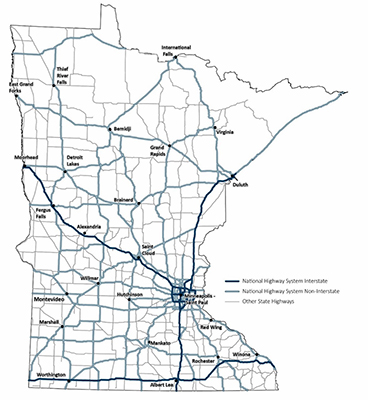
State highway network as of 2022. Graphic from SMTP |
In early January, MnDOT adopted the 2022–2041 Statewide Multimodal Transportation Plan, strengthening the agency’s commitment to providing a convenient, safe, reliable and affordable system that works for everyone.
Updated every five years, the SMTP is the highest policy plan for transportation in Minnesota. The plan outlines objectives, performance measures, strategies and actions to help advance MnDOT’s vision of a multimodal transportation system that maximizes the health of people, the environment and our economy. The document is a statewide policy plan for all users, all modes and any jurisdiction that has a role in Minnesota’s transportation system.
“Everyone deserves transportation options that work for them and their needs,” said Commissioner Nancy Daubenberger. “The SMTP is a cornerstone to the important work that MnDOT and our transportation partners need to do in the near- and long-term to ensure our investments continue to deliver on our commitments to safety, economic vitality and livability. We look forward to working with partners statewide to implement the goals laid out in this updated plan.”
The SMTP evaluates the state’s entire transportation system, considers trends affecting transportation and provides direction for the next 20 years. The updated 2022–2041 plan focuses on six objectives: transportation safety, system stewardship, climate action, critical connections, healthy equitable communities and open decision-making.
In addition to the agency’s long-standing commitment to preserving the existing system, the SMTP also includes new opportunities and emphasis areas, including climate, equity and health.
“Transportation is inherently about the future,” said Hally Turner, Policy Planning Director in the Office of Transportation System Management. “If we only plan for today, our system won’t work as well for Minnesotans in 20 years. The SMTP is a guide to make sure our work today delivers the promises of transportation in the near- and long-term.”
The plan is the result of extensive collaboration during the last two years between MnDOT, partners, stakeholders and the public. The final plan is posted online at MinnesotaGO.org.
Paper copies are also available at the MnDOT Library at Central Office in St. Paul and at the eight MnDOT district headquarters located statewide. |
| |
|

|
 |
TABLE of CONTENTS
|
Staffing updates |
Ronda Allis named new administrative manager for District 7
Ronda Allis has been selected as District 7’s Administrative Manager. She will manage and provide executive leadership to the district’s administrative functions for the effective delivery of transportation products and services, among other duties. She will also participate on various statewide task forces and committees.
Allis started at MnDOT in 2013 and was previously District 7’s Planning Director. She also worked as Planning Director in District 6 and as a Principal Planner in District 7.
Allis holds a bachelor’s degree in government from the College of St. Benedict.

|
Heather Lukes named new assistant district engineer for program support in District 6
Heather Lukes has been promoted to assistant district engineer for program support in District 6. She will oversee the right of way, surveys, structures and traffic areas for the district and will also serve as a member of the District Management Team.
Lukes joined MnDOT in 2009 and has served in various roles as design engineer, project manager and, most recently, district planning director.
She is a graduate of Iowa State University and has worked in the transportation field for more than 24 years.
Mike Joyce named new fleet manager at Fort Snelling Shop
Mike Joyce has assumed the role of fleet manager at MnDOT’s Fort Snelling Shop in Metro District.
He will be responsible for strategic leadership of the shop’s fleet, including plow truck fabrication, fleet procurement, maintenance, management, data analysis, sustainability and administration.
Joyce joins the agency from Metro Transit bus maintenance, where he worked for 24 years. He has experience in both the public and private fleet operations.
Joyce is a graduate of the St. Paul College truck technologies program and holds a bachelor’s degree in career and technical education from the University of Minnesota.
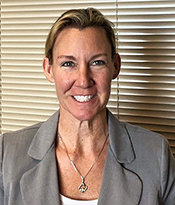
|
Victoria Nill named new assistant district engineer for construction in District 7
Victoria (Tori) Nill has been selected as Assistant District Engineer for Construction in District 7. She will lead the district’s east and west resident construction offices, as well as areas of construction operation including bridge and land management.
Nill has more than 20 years of experience with MnDOT, working in construction, pre-design, final design, traffic and transit. Her specific roles have included serving as the director of the Office of Transit and Active Transportation in Central Office and as acting district engineer for District 4.
Nill holds a bachelor’s degree in civil engineering from the University of Minnesota. |
| |
|

|
 |
TABLE of CONTENTS
 |
New library materials now available |
By Maddie Kuncio, MNDOT Library
The latest issue of New Library Materials is available. This issue features “On Being Included: Racism and Diversity in Institutional Life”by Sara Ahmed.
New Library Materials is a compilation of resources added to the library collection during the previous month. Visit the library webpage and click on “New Library Materials” to sign up. Questions and feedback are welcome at Ask a Librarian. |
| |
|

|
 |
TABLE of CONTENTS
|
On the Job: Mike Ahlman serves drivers who need help |
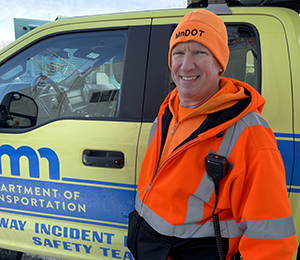
Mike Ahlman. Photo by Anne Meyer
|
By Doug Mack
Mike Ahlman is part of MnDOT’s Freeway Incident Response Safety Team, whose eye-catching chartreuse trucks are a welcome site for drivers who have been in a crash or had their vehicle break down on highways in the Metro area.
How long have you been at MnDOT and in what positions?
I have been at MnDOT for eight years as of this coming August. I started in Maintenance as a Transportation Generalist in August 2015 and left there in April 2019. I came to FIRST in April 2019 and am currently a Highway Helper with them.
What are your day-to-day tasks?
I patrol a route in the Metro area and assist with stalled vehicles on the roadway. I assist with fuel,
coolant/water, flat tires, jump starts, directions and medical situations. I will respond to crashes, and if they are disabled and blocking, I will try to push them out of the traffic lanes to the shoulder if possible to clear the lane(s). I also remove debris from the roadway. Our goal is to minimize congestion and prevent secondary crashes through the quick response and removal of incidents.
What are the most challenging and rewarding parts of your job?
I would say the most challenging part of my job is when I would need to shut down multiple lanes of a freeway to address an incident. With traffic speeds as they are, it takes some thought to do that in a
safe manner so not to cause additional situations such as secondary crashes.
The rewarding part of the job is helping people who are having a bad day. They are so happy I’m
there to resolve their situation in a quick and timely manner.
How has your job changed since you first started?
After the COVID-19 pandemic entered the workplace, we had to be especially diligent in keeping
our trucks and equipment clean. Also need to wear masks sometimes, if necessary.
Is there anything about your job that might surprise other people (either inside or outside
MnDOT)?
We are the only non-law enforcement agency in the state of Minnesota to do custody tows of abandoned vehicles left on the roadway.
What are your interests or hobbies outside of work with MnDOT?
I like to golf during the summer and downhill ski in the winter when I have an opportunity. I am an avid walker and like being outdoors.
Do you or a co-worker have an interesting job to share with readers? Send us your ideas, and we’ll contact you for more information.
Recent employee profiles:
|
 |
|

|
 |
TABLE of CONTENTS
|
Dave Conkel receives Outstanding Service award |
By Doug Mack
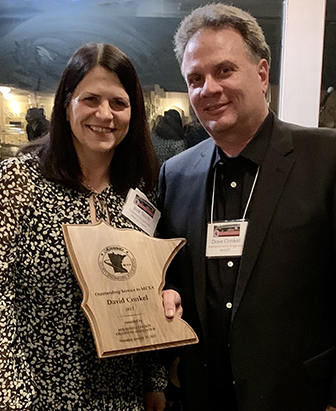
Dave Conkel receives the Outstanding Service award from the Minnesota County Engineers Association. Photo courtesy of State Aid
|
State Aid Bridge Engineer Dave Conkel received the Outstanding Service award at the Minnesota County Engineers Association’s annual conference in January. The honor recognizes Conkel’s work and legacy in his 22-year career.
Conkel is MnDOT’s longest-serving State Aid Bridge Engineer and has worked on many projects large and small around the state, including landmarks like the Sauk Rapids Regional Bridge, the Old Cedar Bridge in Bloomington and the Franklin Avenue Bridge in Minneapolis. Prior to joining the agency, Conkel worked at HNTB, where was one of the designers of the Hennepin Avenue suspension bridge in Minneapolis – a project he is now revisiting as part of the team working on rehabilitation of the same bridge.
“Dave is a great leader in state aid bridges,” said Ted W. Schoenecker, assistant division director of State Aid and Statewide Radio Communications. “He and his team have been some of the strongest advocates, supporters and advisors for local agencies in helping them build, rehab and maintain their bridges across the state.” |
| |
|

|
 |
TABLE of CONTENTS
|
Message from the Commissioner: Building the future of transportation in 2023 and beyond |
By Commissioner Nancy Daubenberger
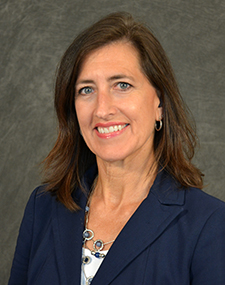
Commissioner Nancy Daubenberger
|
With January already behind us and this year’s legislative session well underway, it feels like 2023 is flying by! As public servants, as transportation professionals and as Minnesotans, we’ve all been through a lot over the last few years, and I wanted to take a few moments to reflect on where we’ve been and what lies ahead for MnDOT.
It’s been a true honor to serve as Transportation Commissioner since last March and to have recently been recommended for confirmation by the Senate Transportation Committee. Over the last year as Commissioner and throughout my 23-plus years with MnDOT, I’ve had the privilege of working with and learning from so many of you. One thing I know we all understand is that the work we do across this agency has a direct impact on the quality of life of our fellow Minnesotans every day – and it’s so important that our agency’s mission and core values reflect that responsibility.
In the next few months, we’ll be rolling out MnDOT’s updated 2023-2027 Strategic Plan, which has been shaped by feedback that MnDOT employees statewide have provided since 2020. Several other items – including our newly adopted Statewide Multimodal Transportation Plan, the federal Infrastructure Investment & Jobs Act, and Gov. Walz and Lt. Gov. Flanagan’s One Minnesota Budget – are also guiding the final revisions to our Strategic Plan.
Last week, I had the opportunity to join Gov. Walz and Lt. Gov. Flanagan as they rolled out our administration’s budget and bonding recommendations – investing in our state’s economic future, children and families, health and safety, and ensuring state government works for everyone.
I’m grateful that many of MnDOT’s requests to help stabilize transportation funding are included in the Governor and Lt. Governor’s proposals, which are detailed further in this week’s edition of Newsline.
The Legislature is also quickly moving this session to approve the necessary budget authority for MnDOT to deliver on hundreds of millions of federal dollars included in the bipartisan IIJA – including about $170 million per year, on average, to MnDOT.
Looking further down the road this year, there’s more good news and important work coming, including:
- Implementing Minnesota’s Electric Vehicle Infrastructure Plan, which will investment $68 million over five years to install fast chargers for EVs, first focusing on Minnesota’s existing Alternative Fuel Corridors, I-94 and I-35.
- Engaging the public to update the Minnesota State Highway Investment Plan, including key themes of investing in our existing system: improving mobility, accessibility and safety for all users; adapting to a changing future; and focusing on communities and livability.
- Continuing to make progress on our equity and sustainability goals, decarbonizing transportation, embracing innovation and advancing technology, all while being good stewards of resources and ensuring our service delivery, safety and maintenance efforts remain at the high levels that Minnesotans have come to expect from this world-class agency and our dedicated staff.
In the year ahead, I look forward to seeing more of you in person and continuing our essential work together. Each of you plays a role in MnDOT’s success. Thank you for all you’ve done and continue to do to ensure a safe, efficient and reliable multimodal transportation system is accessible to everyone in Minnesota. |
| |
|
|
|



